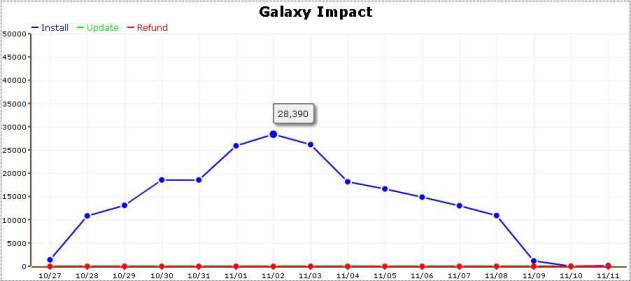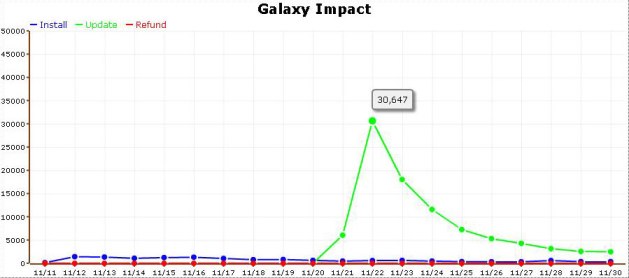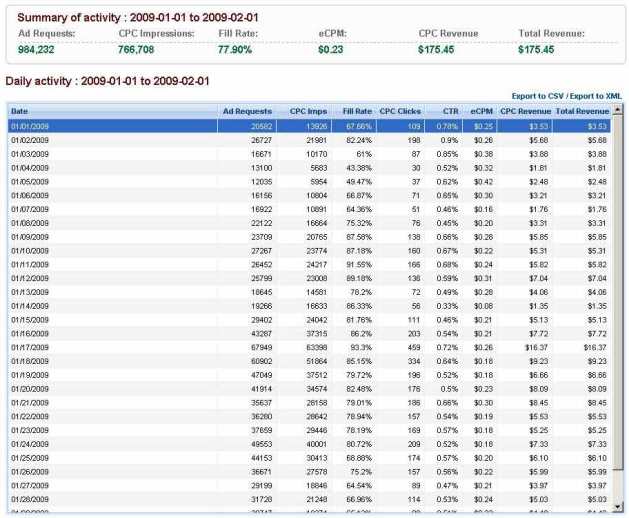This is a guest post written by Bo Wang from iPhone app developer house Team iBokan, part of Bokan Technologies, about the lessons learned while conducting a pricing experiment on brick game Galaxy Impact, the company’s first iPhone application. For a different take on paid versus ad-supported iPhone apps, read our previous post on the subject.
Galaxy Impact, a classic brick-break game and the first iPhone app created by Team iBokan, went on sale in iTunes App Store on Oct 27, 2008, free of charge. It had about 220,000 downloads in its first two weeks and was ranked as No 10 in “Top Free Apps” in the Game category and No 20 in “Top Free Apps” overall, before we started charging a $.99 fee for purchases on Nov 9th 2008.
Here are the details:
Galaxy Impact downloads before start charging $.99

The downloads for Galaxy Impact in its first two weeks, broken down:
* 10/27: 1,377 (the first day on sale)
* 10/28: 10,839
* 10/29: 13,110
* 10/30: 18,875
* 10/31: 18,556
* 11/01: 25,898
* 11/02: 28,390
* 11/03: 26,156
* 11/04: 18,182
* 11/05: 16,633
* 11/06: 14,883
* 11/07: 13,024
* 11/08: 10,928
* 11/09: 1,153 (started charging: 27 downloads PAID)
* 11/10: 23
* 11/11: 20
* 11/12: 1,435 (free of charge again)
So the free downloads vs for-fee downloads is about 400:1. That means for 220,000 downloads, our revenue amounted to $550. It’s obvious that there was no way we could make money out of this with a $.99 list price.
Another lesson learned: before the price change (from free to $.99), average downloads per day was above 10,000 but after price changed back to free, the average rebounced to about 1,000 per day, which continued for a long time. If we had not experimented with charging for the app, the total number of downloads would have been much higher.
Next, we decided to try advertising and updated Galaxy Impact with ads from Admob along with other new features. There was a huge spike of update downloads with a 30,647 peak of November 22, two days after the update release.
Galaxy Impact Downloads after Update

As you can see, the huge traffic for the update does not increase the number of new downloads, even if the app remains free of charge. To this day (Mar 18th), there are about 500,000 downloads in total and about 160,000 updates (one third of new downloads). Note, only updates have ads.
So how was Galaxy Impact doing with advertising powered by Admob? Let’s take a peek at the first month of the year.
Ad revenue from Admob for Galaxy Impact (Jan 2009)

The highest daily ad revenue was $16.37 (on 17 January) and right now it’s about $2.50 per day.
Here’s our monthly ad revenue, broken down:
* Nov 2008: $70.81 (11/20 – 11/30)
* Dec 2008: $236
* Jan 2009: $175
* Feb 2009: $142
* Mar 2009: $67 (03/01 – 18)
With no update or marketing, the current rate of free downloads for Galaxy Impact is about 120 per day. If we apply for-fee ratio, this transfers to about 0.3 daily downloads at a $.99 price, which leads to revenue of $.21 for us, or about 8.4% of what we are making right now on a daily basis ($2.50).
Conclusion
In the case of Galaxy Impact, we have done absolutely no marketing and did 2 updates with new features.
1. Free downloads vs for fee downloads ($.99) is 400:1
2. New downloads vs updates is about 3:1
3. If you decide to go with ad support, do it from the very beginning.
4. Updating does not help much
5. Ad revenue in the long run is higher than sales revenue
6. It’s hardly a sustainable business for most common app developers (with average apps).